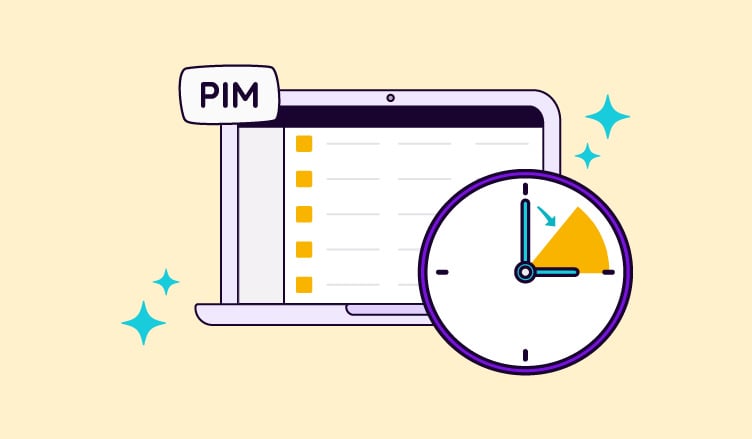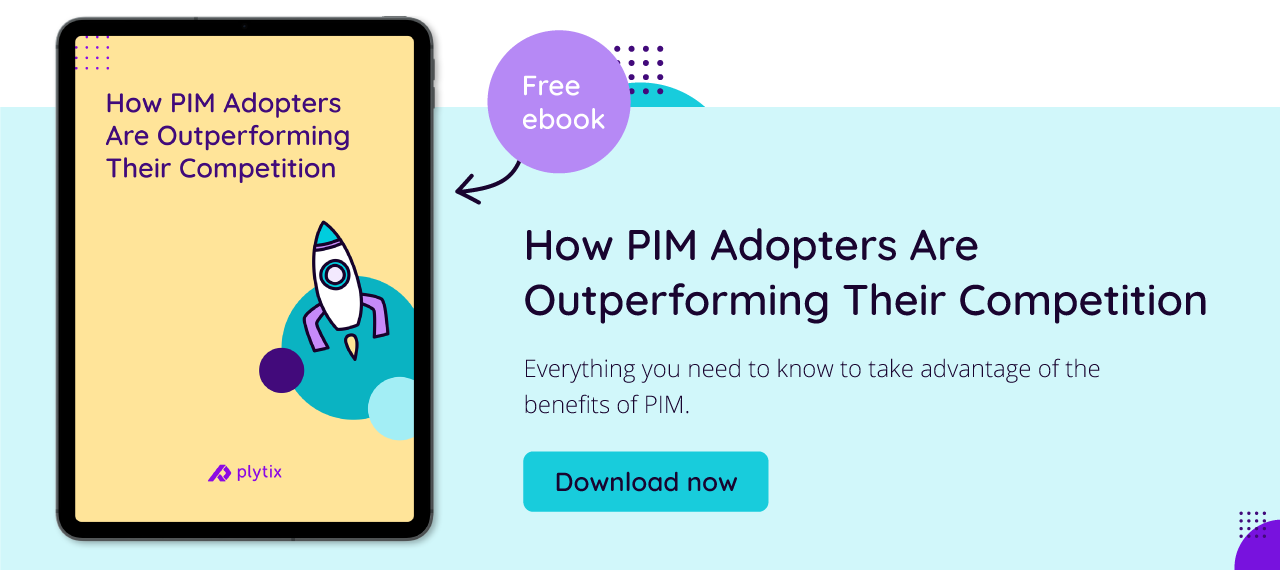
Keep the good stuff coming
Subscribe to our blog newsletter and get monthly content that helps you manage product data smarter.
No spam. Just real value.
If you want to get a task done quickly, give it to a busy person. If you want to get it done really quickly, though, give it to an ecommerce manager—they’re the true experts in getting 120 minutes out of an hour.
Still though, if you’re the one handling your product information and you don't have the right tech in your toolbox, dealing with all your data can take up way too much precious time. If only there was technology available to help, especially whenever you need to add, edit, remove, or share information…
How PIM software saves you time
That’s why, unlike wearing a watch as a belt, using PIM software is not a waste of time (get it? Like waist? No?). At its core, this software is designed to help you get all your product information in one place, change whatever you need to change once it’s there, and then help you get it out into the wider world.
While that might not sound like a recipe for the time of your life, it can actually make all the difference for your online retail business. Put simply, being able to manage your product information in an efficient way frees up time—time that can then be spent on other, more beneficial tasks for you and your company (like coming up with terrible time-related puns, in my case).
But how exactly does this technology save us time? In more ways than I can count, to be honest, but let’s just look at my top seven for now ...ready when you are!
#1: Easy data uploads
Remember working on group projects at school? Do you also remember the joy of getting the information you needed from the rest of your group? At least in my case, I remember spending far too long chasing up individual contributors just to get them to share their data, all for the simple task of getting everyone’s work in one place so we could actually, you know, work on it.
Luckily, this isn’t normally such an issue in the world of work, but getting the data you need from your team or your suppliers can still be an issue. Without PIM, you could well be receiving product information from your different suppliers or departments in the form of a mess of spreadsheets, Dropbox or Drive folders, or even *shudders* Powerpoint presentations.
PIM software provides an easy way to avoid this issue. Using a PIM tool means you can give everyone access to the same central system, where they can add their data directly in the correct format—without you having to spend time getting it from them and then reformatting it yourself.
#2: Efficient collaboration
Okay, so that covers getting data into one place, but what about accessing it once it’s there? It’s all well and good giving people the ability to send product information to one central repository, but what about viewing or editing it later on? What if different people are accessing the same data at the same time? Is it going to be like when you’re working on a shared Google Doc, and one of your colleagues makes the super helpful decision to completely change the format or view, making you lose whatever you were just working on? I mean, I know teamwork makes the dream work and all that, but that doesn’t really apply if everyone’s getting in each other’s way.

Fun fact: "We're All In This Together" is actually about running an ecommerce company. [source]
With PIM software, users can access or edit product data anytime, anywhere, as long as they have internet access. This means that whether someone’s on a beach in Bali or in a boardroom in Boston, they can make instant updates to your product listings, making sure your information is always accurate and up-to-date.
On top of that though, there are also specialized PIM features to help with collaboration, like custom user views which let everyone work on the data in the way they want but without disrupting other people’s work. This might not sound that exciting, but in practice, it can end up saving so much time by giving users the option to immediately open their own custom view and have all the information they need at their fingertips every time they log onto the system.
#3: Exhaustive access control
I know what you’re thinking, though—what if I don’t want everyone to have access to all my data? I know I don’t want my suppliers to see everything in my database, and to be honest, maybe I don’t want everyone on my team to have access either. I mean, why does Dave from Marketing need access to our distributors’ billing information? Not everyone needs to know how the sausage is made, right?
Without PIM software, controlling access levels generally leads to working with data silos, a.k.a. a whole bunch of different out-of-sync versions of the same data that one person or team then has to combine later on. PIM software, though, allows you to customize user permissions so that the right people have the right level of access. Whether it's adding new products, editing existing listings, or just viewing the data, you can set permissions based on roles within your organization.
For your suppliers, you can also set up your system so that they can feed information into your database but can’t view or edit anything once it’s in there—whatever works for your organization. This tailored access control helps maintain data integrity and security while still making that all-important collaboration and process automation possible.
#4: Good DAM features
You know what’s a great use of time? Using different systems for your technical product information and for your digital assets (i.e. photos, videos, documents, and so on). Between the constant jumping from one system to another, the lack of information-sharing, and the inevitable data discrepancies that happen as a result, it’s really just a rollicking good time all around.

Data silos: not a fun way to party down. [source]
Okay, so maybe the sarcasm was a little strong there, but you see my point. Having your data and your assets in separate systems just doesn’t make sense, and storing your stuff this way will end up wasting a lot of time as a result.
Now imagine having all your product photos, videos, and documents stored in the same place where your product information lives. That's exactly what you get with a PIM system that includes digital asset management (DAM). This integration means you can easily attach relevant media to product listings without anyone having to sift through folders looking for a file called "Final_Final2_Updated3.jpg"—everything is organized and accessible within the same system.
#5: Completeness checks
You know that feeling when you’ve just left for a trip, and you can’t shake the thought that you’ve left something behind? So you run through everything you need in your head and think about what you’ve packed, and it seems you’ve got everything, but there’s still that nagging feeling that you’ve forgotten something? Well, if you ever want to recreate that feeling at work, there’s a simple solution—just try and answer the question: "Is this product listing ready to go live?"
Still though, wouldn’t you rather avoid that stress and the time-consuming double- and triple-checking of your data that comes with it? Well, that’s why PIM software comes with data completeness attributes. This feature automatically checks whether all necessary information has been entered and basically creates a built-in checklist for your products to make sure that no essential detail gets left behind.
Using this feature is a huge time-saver, as it drastically cuts down on the back-and-forth and the scramble to update product listings after they’ve gone live. It’s particularly useful if you’re selling on multiple platforms or marketplaces, since each channel has its own particular requirements, as I’m sure you’ve noticed. I’m also sure you’ve noticed that keeping track of who needs what is a slow process at best and a chaotic headache at worst—so why not get tech to do it for you?
#6: Smart lists (for smart people)
If someone’s super successful in ecommerce, they’re unlikely to be listless for a number or reasons (well, two, but the point still stands). Obviously, running a successful online company requires energy and enthusiasm, but it also requires lists, and above all, lists of products for different purposes. At any given moment, you might need a list of all your products being sold through a particular marketplace, or that come from a particular brand, or that are within a certain price range.

“He’s making a list, he’s checking it twice, he’s wishing he could filter by price” [source]
Making all these lists takes time, naturally, but one way to drastically reduce the amount of time involved is by creating smart lists. These are dynamic lists that fill themselves based on criteria you set, such as simple things like collection name or product type or more advanced characteristics like the completeness attributes we were just looking at. The best part, though, is that these lists will continue to update themselves over time, meaning once you’ve gone through the initial setup you’re, well, set—no more manual product list updates.
But wait, there’s more! The fact that you can combine different characteristics and criteria in these lists gives them limitless possibilities. As an example, this feature means you could get your PIM tool to automatically generate a list of only products from a certain brand, within a certain price range, and that have all the necessary information for a certain marketplace 100% complete. Once you’ve made that smart list, any time you add a product to your database, it’ll get added to that list too, without you having to spend precious time updating the list yourself—magic.
#7: Dynamic data distribution
Of course, there’s one last time-consuming hurdle we need to get over when it comes to your data: getting it out into the world. If you’re doing everything without the benefit of software, this’ll mean a lot of manual data edits and uploads for each of your sales channels, often with multiple spreadsheets and files being uploaded to each platform. If only there was some way to send your product information flying out to your marketplaces and stores in a more efficient way?

Actual footage of the Wicked Witch sending her products (mostly shoes) to market. [source]
If you haven’t spotted the pattern of this article yet, this may come as a shock to you, but ...guess what? PIM software can help! The ability to distribute your product information quickly and automatically to various channels, be it your ecommerce site, marketplaces, or social media, is a game-changer, and PIM software is what lays the groundwork for that ability.
Depending on the channel in question, your PIM tool will either let you quickly gather all your information and multimedia into one convenient file, that you can then upload yourself, or it’ll be able to make that file into a digital product feed, that you can connect to the channel directly and let it pull data from on a schedule of your choosing. In some cases, you may even find software that has a direct integration with ecommerce platforms (like Shopify), which can speed up the distribution process even more.
Other benefits of PIM software
So there you have it! Seven ways that PIM software can save you time. In reality, though, there are so many more advantages to this tech. Don't just take my word for it, though—dive deeper into how PIM software can benefit you and your business by reading the ebook down below. It’s got all the info you need, and you can get the exclusive download link in seconds—how’s that for time efficiency?
Frequently Asked Questions
PIM software provides a centralized system for managing product information, allowing users to easily add, edit, and distribute data across various platforms. It streamlines processes related to data management, collaboration, and distribution, ensuring that product information is accurate, up-to-date, and consistently formatted across all channels.
Ecommerce managers and anyone else involved in online retail businesses can benefit significantly from PIM software. It's especially useful for those dealing with large volumes of product data, multiple suppliers or departments, and those selling across various channels. PIM software is essential for any organization looking to improve efficiency in managing product information and improving their online presence.
A PIM strategy involves the systematic approach to managing product information through centralized software, focusing on improving the efficiency and accuracy of data handling. It involves all the processes for collecting, managing, enriching, and distributing product data, making sure that all stakeholders have access to accurate and timely information. A PIM strategy aims to streamline operations, reduce errors, and improve the overall quality of product listings across all sales channels.
-
Easy data uploads: Simplifies the process of collecting and formatting data from various sources by allowing direct input into a centralized system.
-
Efficient collaboration: Facilitates teamwork by enabling simultaneous access to product data without conflicts, supported by features like custom user views.
-
Exhaustive access control: Allows for the customization of user permissions, ensuring that the right people have the appropriate level of access to data.
-
Good DAM features: Integrates digital asset management, keeping product information and related media in one place for easy access and organization.
-
Completeness checks: Automatically verifies that all necessary product information is present before listings go live, reducing the need for manual checks.
-
Smart lists: Creates dynamic product lists based on specific criteria, which update automatically, saving time on manual list management.
-
Dynamic data distribution: Streamlines the process of distributing product information to various sales channels, reducing manual effort and ensuring consistency.

What if your product data actually worked for you?
We’ll show you how Plytix helps you stop fixing data—and start using it.
Related posts
Keep the good stuff coming
Subscribe to our blog newsletter and get monthly content that helps you manage product data smarter.
No spam. Just real value.










Think others should see this?
Go ahead and share it.